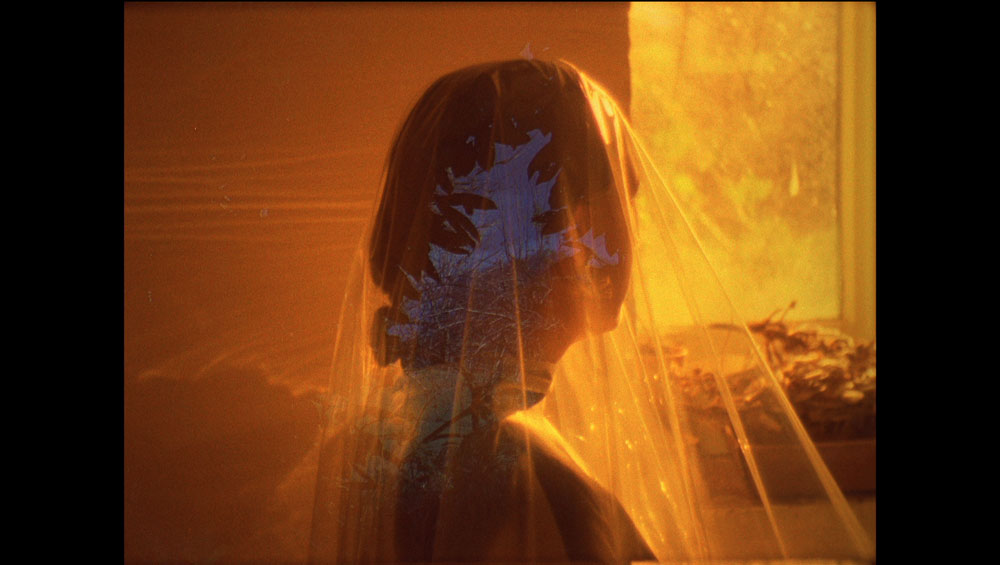
Pump House Gallery, London
10 January – 1 April 2018
by TOM HASTINGS
For her first solo exhibition in the UK, London-based New Zealand artist Sriwhana Spong excavates the Lingua Ignota, a secret language composed by 12th-century mystic Hildegard von Bingen. Across the Pump House Gallery’s four storeys, works ranging from costume to votive offerings, large-scale watercolours and a percussive instrument orbit the show’s centrepiece, a masterful 26-minute film from which the show takes its title.
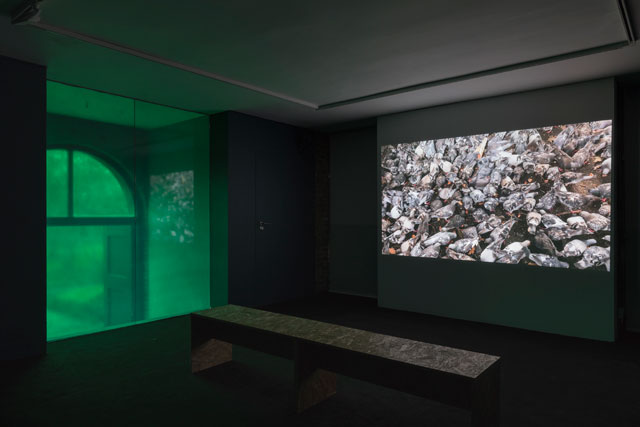
Sriwhana Spong, a hook but no fish, 2017. Courtesy the artist, Michael Lett, Pump House Gallery. Photograph: Damian Griffith.
Having been sequestered in Disibodenberg monastery, Germany, at the age of eight, Von Bingen went on to become a Benedictine abbess, producing a diverse body of literature over a 39-year period. The Lingua Ignota – perhaps the strangest work to emerge from those years – consists of 23 letters, out of which a glossary of 1,000 words was set down by several male scribes whom she enlisted.
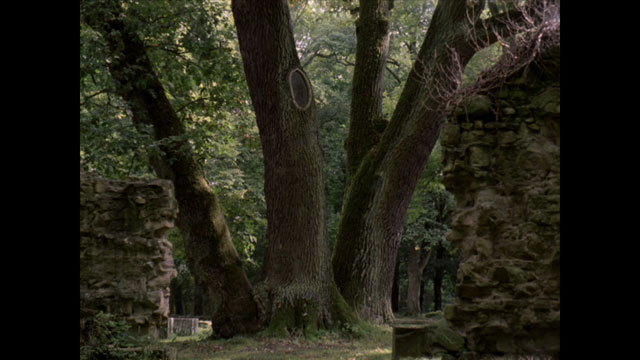
Sriwhana Spong, a hook but no fish, 2017. 16mm transferred to HD and HD video, 24'50. Courtesy the artist, Michael Lett, Pump House Gallery.
The first part of Spong’s film lures the viewer to the monastery’s ruins: fixed 16mm shots of a verdant forest floor, ivy clinging to a trunk and gravestones ravaged by the elements reflect the natural history that clearly informed Von Bingen’s sense-making. A layer of green vinyl covers an entire glass wall separating the viewing mezzanine from the gallery entrance – it is as if the film has spilt through the transom window in order to absorb Battersea Park itself (The gallery is situated by a lake in the centre of the park).
.jpg)
Sriwhana Spong, a hook but no fish, 2017. 16mm transferred to HD and HD video, 24'50. Courtesy the artist, Michael Lett, Pump House Gallery.
“H”, a pseudonym for Von Bingen that implies a kinship with the American poet Hilda “HD” Doolittle, appears later in the film, veiled by a translucent plastic sheet and gazing out of the window in a pose that comes close to Vermeer’s Girl Reading a Letter at an Open Window (1659). “This language offers an unmaking and remaking through the body of a woman,” reads the accompanying subtitled script – a designation that at first seems to conflict with the fact that the Lingua Ignota omits terms to describe mammals, while including words for tools (hence the film’s title), social types and natural elements. For instance, there is no word for “body”, yet we have been bequeathed names for “sweat” (Suinz), “tear (from crying)” (Vguvviz) and “blood” (Rubianz). However, this designation makes sense of H as being herself the origin of language – a proprietorial link that is brilliantly reflected in another part of the film, in which pixelated web images of an unknown woman scrolled from left-to-right form the backdrop to a gossipy dialogue: “I heard he took some photos of the back of her neck, after they broke up. He emailed to ask if he could use them in the exhibition. She said no.”
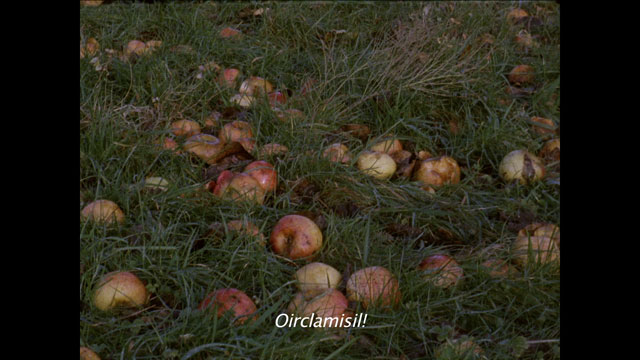
Sriwhana Spong, a hook but no fish, 2017. 16mm transferred to HD and HD video, 24'50. Courtesy the artist, Michael Lett, Pump House Gallery.
Again, a (feminist) kinship is suggested without being identified blatantly. In other memorable shots, horse dung, muddy hay, worms and pigeons fill the screen massively, as if intended to convey the material substrate of the nouns invented by Von Bingen. Words from the Lingua Ignota appear intermittently onscreen, accompanied by an exclamation mark: this finally has the effect of evoking an archaic speaking subject who persists beyond the fantasised body of H.
I am struck by the sensitivity of the artist’s handling of an undoubtedly rich historical archive – in another pair of hands, this source material could easily ossify. The outcome of months spent researching medieval female mystics at the Warburg Institute in London, the exhibition A hook but no fish brings H’s immaculate production into conversation with Balinese tradition, animal ecology, body politics and sense perception. There are echoes of Spong’s last exhibition, having-seen-snake, held early in 2017 at the Auckland-based gallery Michael Lett, which represents her.
,-2017.jpg)
Sriwhana Spong, Instrument C (Claire), 2017. Courtesy the artist, Michael Lett, Pump House Gallery. Produced by Matt Nolan. Photograph: Damian Griffith.
A chance encounter with a garter snake in a Pittsburgh cemetery, while on a residency in the city, led her to delve into the archives of the Carnegie Museum of Natural History. In response, Spong produced a luscious 16mm film that, again, juxtaposes material explorations – a hand-painted section of the reel rushes past onscreen like a snake, overlaid by a menacing hissing sound – alongside an offscreen interview conducted with herpetologist José Padial, the camera dilating on specimens encased in labelled jars. Spong anecdotally recalls the misgivings Padial and his team had over capturing, killing and preserving rare species of snake in order to produce a taxonomy that might then be used to safeguard and conserve others of its kind. The same impulse, I sense, directs Spong’s treatment of the Lingua Ignota here.
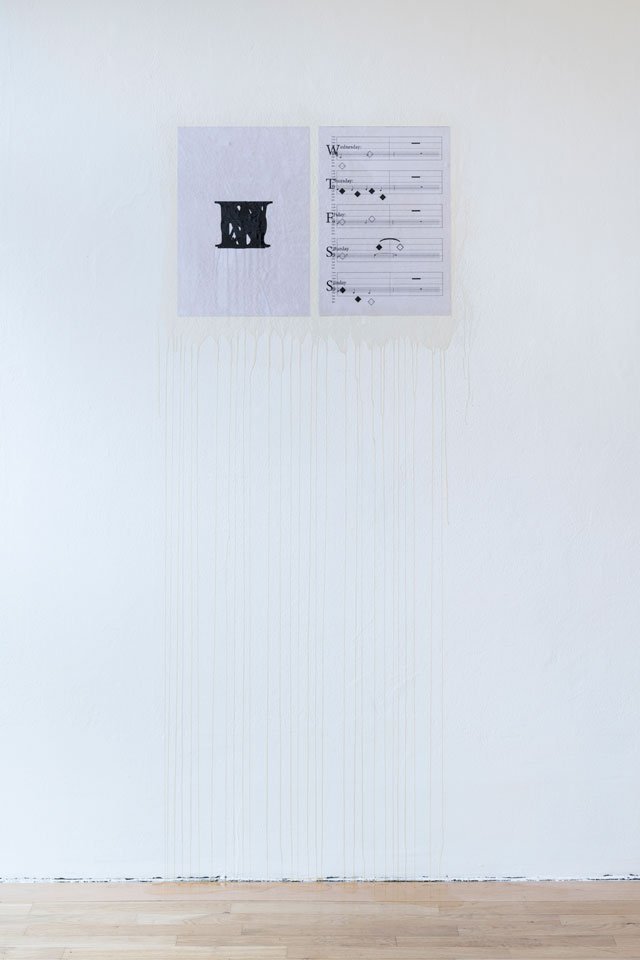
Sriwhana Spong, Cum vox sanguinis, 2017. Courtesy the artist, Michael Lett, Pump House Gallery. Photograph: Damian Griffith.
Climbing to the upper storeys of this Grade I-listed Victorian tower – the artist informs me she has had to think vertically over the months leading to the installation – I enter a brightly lit room overlooked by a balcony on all four sides. Instrument C (Claire), an aluminium bell plate, looms in midair, suspended invisibly from the ceiling. Blue and brown shoelaces are tied loosely around large New Zealand flax and palm leaves that bedeck each side of the plate, rustling and vibrating in response to the tiniest of movements. A score composed by Von Bingen, Cum vox Sanguinis, featuring two superimposed notational systems, is plastered to the wall with honey that, still viscous, drips to the floor. Notes have been transposed to hours, and at different times each day (bar Mondays and Tuesdays) an invigilator strikes the bell plate with a mallet, creating a long-lasting E2 tone.
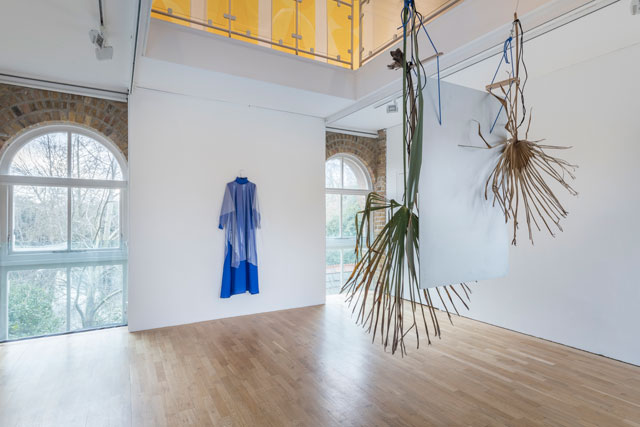
Sriwhana Spong, a hook but no fish, installation view, 2017. Courtesy the artist, Michael Lett, Pump House Gallery. Photograph: Damian Griffith.
Opposite this instrument, an electric-blue dress draped in plastic material is held by a sterling silver hanger. HZ Dress C is patterned after the toile worn by H in the film A hook but no fish, and is so named because its colour is translated from the frequency of the bell plate’s pitch. As suggested by the shared titular “C”, dress and instrument mark the third in an expanding series: Spong’s long-term aim being to construct a gamelan (traditional Balinese) orchestra of custom-built instruments over succeeding exhibitions, a venture that anticipates her next film project, which she plans to shoot in Bali later this year.
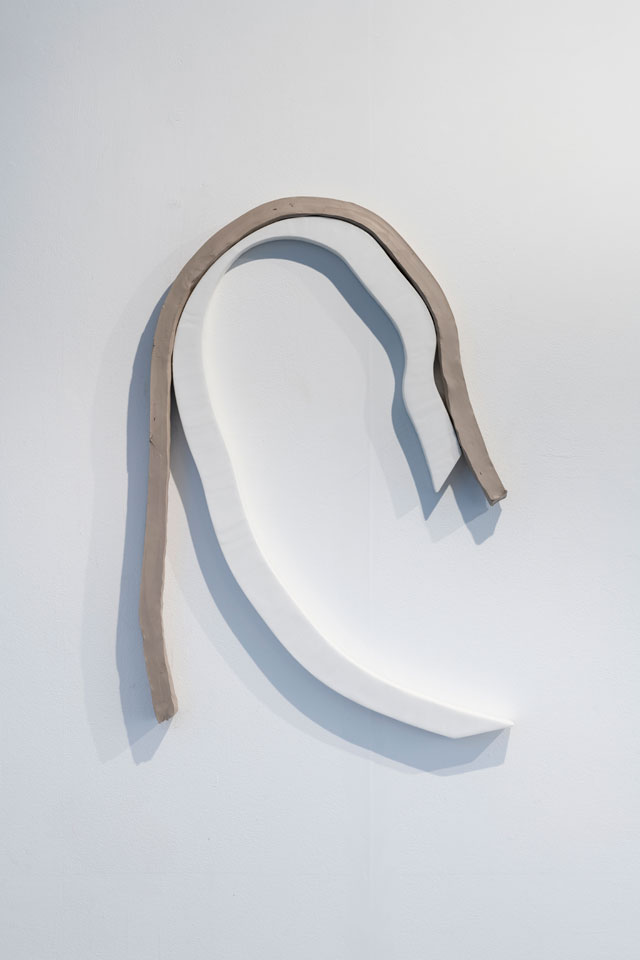
J Sriwhana Spong, Oirclamisil, 2017. Courtesy the artist, Michael Lett, Pump House Gallery. Photograph: Damian Griffith.
On balcony level, my gaze is caught by five floor-to-ceiling watercolours, mirroring a further painting on the opposite wall. Sigil (Rothschild’s mynah) #8-13, part of a series of 17 such works, feature a limited palette of yellow tones applied with a flat brush that are here set off wonderfully by the blue dress vertically below. Playing on the double meaning of “spell,” these finely wrought sigils contain the letters of the name Rothschild – together, they solicit an active viewing that reminds me of Emily Dickinson’s “electric rest”, a phrase alluded to elsewhere by Spong. “Rothschild’s mynah” is the name given to a bird, indigenous to Bali, that now faces extinction, a reality that again reflects the precarity of all attempts to take possession by naming.
-8-12,-2017.jpg)
Sriwhana Spong, Sigil (Rothschild mynah) #8-12, 2017. Courtesy the artist, Michael Lett, Pump House Gallery. Photograph: Damian Griffith.
Returning to the Pump House Gallery’s main entrance, I am greeted by Sanur #1 and #2 (called after the Balinese town where Spong’s father, whom she first met as a young adult, lives). French fries set in two cuboids of paraffin wax, one orderly, the other scattered, have been leant against wall-mounted supports, lending the show a generous, comical edge; together, they evoke Balinese Hindu offerings that are typically left outside the family home. These are accompanied by two laser-cut squiggles of wood, a motif in Spong’s practice, over which are draped wet slabs of clay, set to dry over the course of the exhibition.
A hook but no fish draws unforeseen connections between language, sense, place and time, resolving for a moment, like the Lingua Ignota itself, before sending the viewer questing back up the tower.